Top>Special Program>Roundtable with Joban Kosan Chairman and Executive Director Kazuhiko Saito and Class of 2014 Graduates :Reflecting the path to recovery and post-quake Tohoku
 Index
Index
Roundtable with Joban Kosan Chairman and Executive Director Kazuhiko Saito and Class of 2014 Graduates
Reflecting the path to recovery and post-quake Tohoku
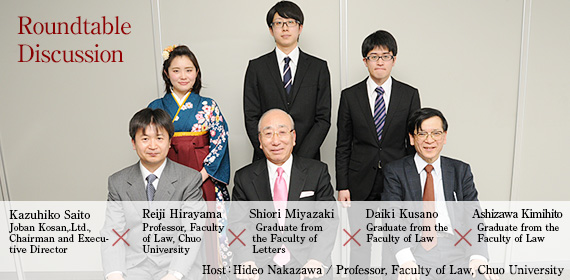
On March 25, 2015, the Class of 2014 graduates celebrated their graduation ceremony at Chuo University’s Tama Campus, joined by alumni Kazuhiko Saito, Chairman and Executive Director of Joban Kosan giving a congratulatory message. After the ceremony, a round-table discussion was held between Saito and graduates with connections to Fukushima and Tohoku. Faculty of Law professors Hirayama and Nakazawa also attended, and discussed the progress in the disaster areas after four years from the Great East Japan Earthquake.
Spirit of “One Mountain, One Family” supporting resumption of business
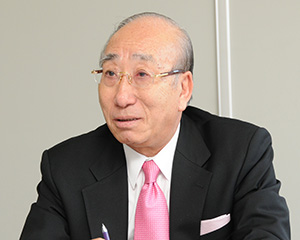
Kazuhiko Saito
- Nakazawa
- In this discussion, I would like to have a message from Chairman Saito to the graduates who worked as volunteers and conducted research and study in Fukushima and Miyagi, which were devastated by the Great East Japan Earthquake. First of all, could you tell us about the progress of “Spa Resort Hawaiians” which is run by Joban Kosan?
- Saito
- Joban Kosan was originally named “Joban Mining Company”, and mined coal in Yumoto Town (now the Joban district of Iwaki City). Yumoto was known as a hot spring district at the time, but hot springs were natural enemies for coal mining. However, when the coal industry went into a decline, the predecessors, in order to secure employment and develop the region, made use of those natural enemies. That was the start of today’s Spa Resort Hawaiians (then Joban Hawaiian Center). Since then we have overcome many difficulties, with this year marking our 50th anniversary. Even if I say so myself, I think we have done well to survive so long.
- Nakazawa
- You no doubt suffered great damage in the 2011 Great East Japan Earthquake?
- Saito
- We didn’t suffer that much damage in the March 11 quake. However, we were devastated by the aftershock that struck one month later. Our company had overcome the exhaustion of coal and the collapse of the bubble economy, but at this time, many employees, including myself, thought our company would go bankrupt this time. However, we received so much support from everyone in the community and managed to reopen 10 months after the quake.
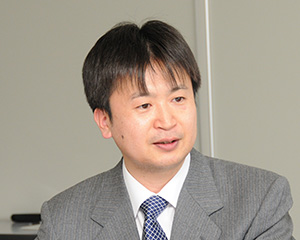
Hideo Nakazawa
- Nakazawa
- In my seminar we stayed at Spa Resort Hawaiians in 2013 and conducted research on Iwaki at the time. I would like to ask Ashizawa, who participated in that research, to share what we found.
- Ashizawa
- We conducted research at the “Iwaki Yotsukura Central Industrial Park” in Yotsukura Town, Iwaki City. Small and medium-sized business which had evacuated due to the nuclear plant accident was operating temporary factories here. We covered two of those companies. Although both companies had run community-based operations up until the disaster, relocating their base relations with almost all their customers had ground to a halt. Although they managed to continue operations through the help of other companies in the same industry and old customers, both presidents said they will be difficult to expand operations in the future. Reasons behind this can be given as an unwillingness to take business away from other companies in the industry, refraining from expanding the area of the factory, and the problem of successors.
- Saito
- In Fukushima there are many companies that are deeply rooted in the area. Our company has also moved along with the region. In coal-mine industry there is a saying that has continued from the Meiji Era, “one mountain, one family.” It means that the people who work in the mountain are all one family and live and die together. These kinds of bonds greatly helped our company. All of our staff worked hard together, and even our main bank and the local banks allowed us to focus on restoring the company as they said, “don’t worry about funds, we will give you total support.” Chuo University graduates and students also offered a helping hand, so we could get underway. However, in the coastal areas of the same Iwaki City, where marine products and sea bathing were income sources, restoration is still going to take time. I would like everyone to continue giving support to both local companies and those that have evacuated.
Facilitation of mutual understanding and emotional care
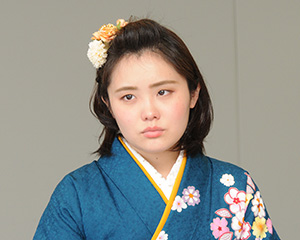
Shiori Miyazaki
- Nakazawa
- Bonding with local communities are important. Kusano from Fukushima, another student who took part in the same study, is going to go to work in Fukushima after graduating. I would also like him to give a report on his research.
- Kusano
- Iwaki, while also being a disaster zone, was an evacuation center for the victims of the nuclear accident at the same time. For that reason, the number of residents increased suddenly, bringing traffic congestion and crowded medical facilities. There was also friction between Iwaki residents and the evacuees, which I conducted research on its causes and solutions. As a result, I believe that a feeling of unfairness was at the root of the friction. Iwaki also received damage from the tsunami, but because it was not as much as the hometowns of the evacuees, there was a gap in financial aid. I proposed three solutions in my thesis. My first solution was to improve mutual understanding and awareness. My second solution was to improve the national policies that led to the feeling of unfairness. My third solution was to spread knowledge of the situation to the rest of the world. In the future, I hope for the realization of recovery policies for the disaster victims, and want to spread knowledge of the situation.
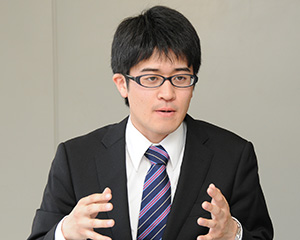
Ashizawa Kimihito
- Saito
- There is no doubt there is a friction between the residents and evacuees. But they are slowly beginning to understand each other’s position. Some of the evacuees cannot return to their hometowns, and if they need to relocate, Iwaki is the limit for them geographically. The people of Fukushima are deeply rooted in their areas, so they will find it hard to move to faraway regions where the climate and temperament of the locals are different. I want to aim to create an environment where there is mutual understanding and they can live together comfortably.
- Nakazawa
- That’s right. On the other hand, Miyazaki’s mother’s hometown is Rikuzentakata City in Iwate Prefecture, and after the disaster, she went to neighboring Kesennuma City in Miyagi as a reconstruction support volunteer leader. I will now have her introduce those activities.
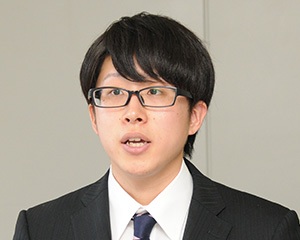
Daiki Kusano
- Miyazaki
- From the end of 2011 I conducted volunteer activities cooperating with a community support group at a temporary housing facility in Kesennuma, and learning support activities for the local children. At the start I was always made to realize my inexperience and immaturity, and felt that I was useless to the disaster victims, but by being involved with children through the learning support activities and the temporary housing shelter activities, I noticed the importance of mutual understanding between each individual. I learnt that university students from Tokyo like myself, victims and children can understand each other through talking, become more positive in thinking, and regain pride.
- Saito
- The area around Kesennuma also received a lot of damage, but the locals and recovery supporters have joined together and are working hard. However, there are still a lot of hardships to come. Including psychological support, I think that continual support is a necessity. The people of Fukushima are reserved in speech and may not look at you and say “thank you”, but they are truly grateful in their hearts. There are a lot of things that we can’t come up with, so even I was helped immensely by those conducting recovery support.
- Research Activities as a Member of Research Fellowship for Young Scientists (DC1), Japan Society for the Promotion of Science (JSPS) Shuma Tsurumi
- Important Factors for Innovation in Payment Services Nobuhiko Sugiura
- Beyond the Concepts of Fellow Citizens and Foreigners— To Achieve SDGs Goal 10 “Reduce Inequality Within and Among Countries” Rika Lee
- Diary of Struggles in Cambodia Fumie Fukuoka
- How Can We Measure Learning Ability?
—Analysis of a Competency Self-Assessment Questionnaire— Yu Saito / Yoko Neha - The Making of the Movie Kirakira Megane








